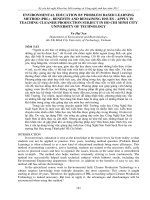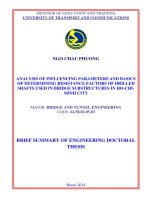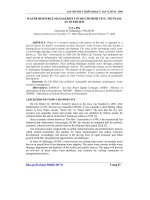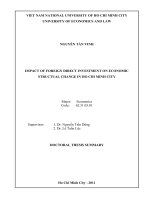Spent coffee grounds collected in ho chi minh city a good source of phenolic acids and fatty acids
Bạn đang xem bản rút gọn của tài liệu. Xem và tải ngay bản đầy đủ của tài liệu tại đây (1.03 MB, 9 trang )
Thu Dau Mot University Journal of Science - Volume 3 - Issue 3-2021
Spent coffee grounds collected in Ho Chi Minh city: A good
source of phenolic acids and fatty acids
by Vũ Công Danh, Vũ Thị Quyền (Van Lang University)
Nguyễn Hà Diệu Trang (Industrial University of Ho Chi Minh City)
Article Info:
Received 6 June 2021, Accepted 2 Sep 2021, Available online 15 Sep 2021
Corresponding author:
/>
ABSTRACT
Coffee is among the favorite drinks in Vietnam and many other countries.
Production and consumption of coffee have released a huge amount of spent
coffee ground. This study aimed to determine phenolic acids and fatty acids of
spent coffee grounds collected in Ho Chi Minh city and how phenolic acid profile
was affected by different environmentally friendly extractants. The results showed
that average level of chlorogenic acid in ethanol/water extracts (840.4 779.9g/g)
was significantly higher compared to water extracts (300.0g/g). Furthermore,
the average total level of phenolic acids in ethanol/water extracts (1215.3g/g dry
weight) was greater than that in the water extracts (779.9g/g dry weight). This
indicated that ethanol/water outperformed water in regard to extraction of
phenolic acids in the spent coffee grounds. Oil extracted from the spent coffee
grounds was rich in linoleic acid (61g/g) and palmitic acid (47g/g). The
findings of our study showed that the spent coffee grounds originating in Vietnam
are a good source of phenolic acids and polyunsaturated fatty acids that could be
utilized for food and nutraceutical production.
Keywords: chlorogenic acid, coffee, nutraceutical, phenolic acids, spent coffee
1. Introduction
Coffee which is produced from seeds of the coffee plant (Coffea sp.) is one of the
321
Vũ Công Danh, Vũ Thị Quyền, Nguyễn Hà Diệu Trang - Volume 3 – Issue 3-2021, p.321-329
favorite drinks in the world. Coffee production accounts for a huge amount of a main
byproduct called spent coffee ground (SCG), approximately 6 million tons per year
(Getachew & Chun, 2017). Research showed that oil and cellulose in SCG can be used
in production of biodiesel, hydrogen, ethanol, sorbitol, mannitol, arabitol and xylitol
(Kondamudi, Mohapatra, & Misra, 2008; Mussatto, Machado, Martins, & Teixeira,
2011). In addition, fiber, essential amino acids and aroma compounds in SCG were
suitable for bakery and beverage products (Martinez-Saez et al., 2017; Sampaio et al.,
2013). Phenolic compounds, such as chlorogenic and gallic acids, in SCG can be
exploited as health-promoting food ingredients (Iriondo-DeHond et al., 2019).
Vietnam is the second largest coffee producing country with more than 1.6 million
metric tons in 2019 (World Atlas, 2016). Domestic coffee consumption in Vietnam is
about 180 thousand metric tons, equivalent to 1.68 kg/person (Ministry of Agriculture
and Rural Development, 2020). This hints at a huge amount of SCG that may have been
released in the country. Previously, this byproduct is often dumped into general waste
and sent to landfill from which it can emit methane, causing multiple environmental
issues. To our knowledge, no approaches to valorizing SCG have been explored with
respect to food and nutraceutical productions. This could be due to limited information
about phytochemical composition of SCG. The aim of this study was to explore
phenolic and fatty acids of SCG obtained during the brewing of Vietnamese coffee. We
investigated how the use of nontoxic, inexpensive, environmentally friendly solvents
affected phenolic profiles of SCG. This work will not only give a better understanding
of phenolic and fatty acid compositions of SCG originating in Vietnam but also help
identify new applications of SCG in food and nutraceutical industries.
2. Materials and methods
2.1. Chemicals
Phenolic standards, including gallic, cinnamic, chlorogenic, caffeic, p-coumaric, ferulic
acid, 2,4-dihydroxybenzoic and salicylic acids, were purchased from Sigma-Aldrich (St.
Louis, MO, USA). Methanol, ethanol, ethyl acetate and acetone were purchased from
Xilong Chemical (Guangdong, China).
2.2. Preparation of SCG extracts
Spent coffee grounds collected from popular coffee shops in Ho Chi Minh city were
pooled together and dried for about 5 hours at 45 C to obtain a moisture < 5% (Figure
1). The dried SCG was mixed with solvents (aqueous ethanol and deionized water) at a
ratio of 30 g/100ml. After shaken for 24 hours on a shaker, the mixtures were filtered
through a Whatman filter paper, and the filtrates were injected into a high-performance
liquid chromatograph (HPLC).
322
Thu Dau Mot University Journal of Science - Volume 3 - Issue 3-2021
Figure 1. A photo of dried spent coffee ground collected from a coffee shop located in
Ho Chi Minh city
2.3. Determination of phenolic acids
The analysis was carried out on a Shimadzu LC-2030C HPLC coupled to a diode-array
detector (HPLC-DAD) and equipped with a VertiSep™ GES C18 reverse-phase
chromatographic column (250 × 4.6mm, 5.0µm particle size). Methanol (A) and 1%
formic acid in water (B) were used as a mobile phase, with the composition varying as
follows: 0 to 3 min, 25% A; 3 to 5 min, 25% to 40% A; 5 to 16 min, 40% to 60% A; 16
to 21 min, 60% A; 21 to 24 min, 60% to 80% A, 24 to 27 min, 80% A, 27 to 35 min, 80
to 25% A. The elution was performed at a flow rate of 0.8mL/min and the column
temperature was set at 40 C. The detection of phenolic acids was set at a wavelength of
275 nm. Data were analyzed using LabSolutions software (Shimadzu, Kyoto, Japan).
Quantification of phenolic acids was based on calibration curves constructed using five
concentrations (0.1, 0.25, 0.5, 1, 5μg/ml).
2.4. Determination of fatty acids
Oil from SCG was extracted following the technique described by Vu et al. (2019) (Vu,
Lei, Sumner, Coggeshall, & Lin, 2019). To determine fatty acids, the oil was
methylated with BF3/methanol (1ml) for 45 min at 60C . Analysis of fatty acids was
carried out using Shimadzu gas chromatograph 2010 connected with flame ionization
detector set at 280C. The temperature gradient was at 100-230C at the rate of 7 ℃/min
with nitrogen as a carrier gas.
2.5. Statistical analysis
One-way analysis of variance (ANOVA) was carried out on the data obtained to
compare phenolic levels between SCG samples. The significance difference between
mean values was determined with the Tukey HSD test (p<0.05).
3. Results and discussion
3.1. Extraction and HPLC analysis of phenolic acids
Phenolics are a class of naturally occurring compounds that have aroused much
attention due to their bioactivities of importance to human health. The analysis of
phenolics in plants can be performed using liquid-solid extraction. One of the factors
that are likely to have impacts on a liquid-solid extraction method is extraction solvents.
323
Vũ Công Danh, Vũ Thị Quyền, Nguyễn Hà Diệu Trang - Volume 3 – Issue 3-2021, p.321-329
cinnamic acid
PDA Multi 1 275 nm
salicylic acid
dihydroxybenzoic acid
ferulic acid
p-coumaric acid
caffeic acid
gallic acid
chlorogenic acid
For this reason, we evaluated the extraction of SCG phenolics using two solvents,
namely EtOH/water (1:1) and deionized water. These are commonly used for extraction
of SCG phenolics (Choi & Koh, 2017; Zengin et al., 2020), and importantly, are
regarded as environmentally friendly solvents. Eight phenolic acids (gallic, chlorogenic,
caffeic, p-coumaric, ferulic acid, 2,4-dihydroxybenzoic, salicylic and cinnamic acids)
were simultaneously screened for the SCG using HPLC-DAD. These are the phenolics
which a large number of prior studies were focused on. Figure 2 displays a
chromatogram of the phenolic acids in a standard solution. Table 1 shows retention
times of the phenolic acids monitored. Gallic acid was the first phenolic to elute (4.93
min) while cinnamic acid was the last to come off the column (23.48 min).
Figure 2. A HPLC-DAD chromatogram of phenolic acid standards
As seen in Table 1, we used the linear relationship to fit calibration curves over the
concentration range between 0.1 and 5μg/ml. Figure 3 graphically displays the
calibration curve for chlorogenic acid which is used to illustrate the results of
calibration. The correlation coefficients (R2) for the calibration curves are shown in
Table 1, and these values are all higher than 0.99.
TABLE 1. Retention times, calibration curves and linear correlation coefficients of the
phenolic acids
Compound
Gallic acid
Chlorogenic acid
Caffeic acid
p-Coumaric acid
Ferulic acid
DA*
Salicylic acid
Cinnamic acid
Retention time, min
4.93
10.22
12.30
16.06
17.00
18.83
21.25
23.48
Linear equation
y = 35069.4 x
y = 41527.5 x
y = 72708.7 x
y = 82326.3 x
y = 64854.2 x
y = 19028.0 x
y = 20296.6 x
y = 140343.0 x
* 2,4-dihydroxybenzoic acid
324
Correlation coefficient, R2
0.999
0.998
0.999
0.999
0.999
0.999
0.999
0.999
Thu Dau Mot University Journal of Science - Volume 3 - Issue 3-2021
Area, 105
Conc, g/mL
Figure 3. The calibration curve for chlorogenic acid is representative of the calibration
results.
3.2. Phenolic acids in SCG
Table 2 shows the concentrations of the eight compounds in the SCG extracts obtained,
expressed as g/g of dry weight. The results demonstrated that EtOH/water was the
excellent solvent for extracting chlorogenic acid (CGA) in SCG as the concentration of
this phenolic acid in the aqueous ethanolic extract (840.4g/g dry weight) was much
higher than that in the aqueous extract. EtOH/water was also a great extractant for pcoumaric, ferulic and dihydroxybenzoic acids. As shown in Table 2, the EtOH/water
extract contains a significantly higher level of phenolic acids compared to the aqueous
extract (p < 0.05). Reportedly, EtOH/water performed better than water regarding
extraction of phenolics in SCG and coffee silver skin (Zengin et al., 2020).
Interestingly, water proved to be an efficient extractant for SCG phenolic acids,
particularly CGA, caffeic and ferulic acids. For example, water was shown to possess a
higher extraction capacity for caffeic acid. The caffeic acid concentration value (348
g/g dry weight) in the aqueous extract was 2.5 times higher than that in the aqueous
ethanolic extracts. We also used a biplot to graphically present data on the solvents and
phenolic acids. As illustrated in Figure 4, two principal components (PC1 and PC2)
account for 99.62% of the total variability. Besides, it shows the aqueous ethanolic
extracts were closely linked to CGA, p-coumaric, salicylic acids while the aqueous
extracts were associated with gallic and caffeic acids. In general, our results were
compatible with the report of Angeloni et al. (2020), pointing out a greater extraction
capacity of EtOH/water. And though a combination of water and ethanol enhances the
extraction of most of the monitored phenolic acids, it reduces the extraction of gallic
acid. The findings showed that both EtOH/water and water were efficient extractants for
extracting bioactive phenolics in SCG, and importantly, these are environmentally
benign solvents.
Chlorogenic acid is an important bioactive dietary phenolic compound produced by
certain plants and is a major compound in coffee. It has been shown that this acid
325
Vũ Công Danh, Vũ Thị Quyền, Nguyễn Hà Diệu Trang - Volume 3 – Issue 3-2021, p.321-329
exhibits multiple health-promoting properties. For example, dietary consumption of
CGA may lead to a remarkable reduction in systolic and diastolic blood pressure
(Yamaguchi et al., 2008). Evidence also suggests that CGA in coffee affects body
weight through inhibition of an accumulation of hepatic triglycerides(Shimoda, Seki, &
Aitani, 2006). In addition, CGA has been touted as having anticancer effects arising
from its capacity to scavenge free radicals (Tajik, Tajik, Mack, & Enck, 2017). The
abundant presence of natural component like CGA in SCG helps highlight nutraceutical
values of this byproduct and also suggests a utilization of this byproduct as an
ingredient for food or nutraceutical productions.
TABLE 2. Phenolic contents (g/g dry weight, n = 3) in the SCG extracts by different
solvents
The present study (2021)
Phenolics
Retention
time, min
4.93
10.22
12.30
16.06
17.00
18.83
21.25
23.48
Gallic acid
Chlorogenic acid
Caffeic acid
p-Coumaric acid
Ferulic acid
DA
Salicylic acid
Cinnamic acid
Total phenolic acids
Angeloni et al. (2020)
EtOH/water
Water
EtOH/water
Water
11.8 0.5 b
840.4 32.1 a
98.2 1.1 b
91.1 4.0 a
123.8 1.0 a
46.4 0.2 a
3.2 0.0
0.3 0.1 b
1215.3 36.3 a
28.3 0.5 a
300.0 22.3 b
348.0 13.4 a
7.1 0.3 b
72.8 9.5 b
23.1 5.6 b
NA
0.4
1184.1
6.7
0.2
0.7
NA
NA
0.1
2987.8*
2.3
1019.4
2.5
0.1
0.3
NA
NA
0.1
2133.1*
0.6 0.1 a
779.9 36.0 b
Data are shown as mean standard deviation. Samples were analyzed in triplicate. Values for the same
phenolic acid followed by different letters indicate statistically significant difference (p < 0.05).
NA: not detected or not reported
*: values were reported for a total number of 30 bioactive compounds in SCG.
Biplot (axes PC1 and PC2: 99.62 %)
5
DA
4
3
PC2 (1.32 %)
2
1
GA
EtOh/water
water
0
SA
-1
-2
CAF
COA
CGA
CNA
-3
FA
-4
-5
-5
-4
-3
-2
-1
0
1
2
3
4
5
6
7
PC1 (98.30 %)
Figure 4. A biplot displaying the phenolic information on the SCG extracts.
Abbreviations: gallic acid (GA), chlorogenic acid (CGA), caffeic acid (CAF), pcoumaric acid (COA), ferulic acid (FA) and cinnamic acid (CNA).
326
Thu Dau Mot University Journal of Science - Volume 3 - Issue 3-2021
3.3. Fatty acids
As shown in Table 3, the results demonstrated that the oil contained mostly linoleic acid
(61g/g oil), followed by palmitic acid (47g/g oil). Besides, stearic and oleic acid are
found to be present in the oil, at the levels of 10 and 15 g/g, respectively. The results
are in agreement with prior research on Vietnamese coffee by Sung et al. (2015) (Sung,
Jung, Sin, Kim, & Wee, 2015). Linoleic acid is a polyunsaturated fatty acid found
abundantly in vegetable oil. Our study showed that the level of this fatty acid in the
SCG resembled that of corn oil (Dorni, Sharma, Saikia, & Longvah, 2018).
SCG oil was known to contain high portion of glycerides that can be converted into
biodiesel. A study revealed that polar components in SCG oil had a high free radical
scavenging activity that can be an alternative to BHT in cooking oil (Hwang, WinklerMoser, Kim, & Liu, 2019). Fatty acids in SCG oil are considered an inexpensive and
suitable substrate for microbiological production of poly (3-hydroxybutyrate), an
alternative to synthetic polymers (Obruca, Benesova, Kucera, Petrik, & Marova, 2015).
TABLE 3. Fatty acid composition of the researched SCG
Fatty acids (g/g oil)
Palmitic acid
Stearic acid
Oleic acid
Linoleic acid
The present study (2021)
47
10
15
61
Sung et al. (2015)
39.8
8.5
13.4
63.3
4. Conclusions
In summary, our study revealed that SCG samples prepared from Vietnamese coffee
were a good source of phenolic acids, such as chlorogenic, p-coumaric and ferulic acids.
It also provided a characterization of phenolic profiles of SCG extracts by ethanol and
water. Thereby, it demonstrated that the use of those environmentally benign solvents
allows for a high extraction capacity of phenolics. In addition to phenolics, fatty acids,
such as linoleic and palmitic acids, were shown to be present abundantly in the SCG oil.
Our study has contributed information about phytochemicals of byproducts of coffee
originating in Vietnam. We hope that our study will inspire more research into SCG and
initiate more applications of SCG in the fields of food and nutraceuticals. From the
perspective of sustainable production and consumption, the valorization of SCG could
help increase coffee values, lower the disposal of the waste, reduce negative impacts on
the environment and production cost and coffee product prices.
Acknowledgments
The authors would like to thank Van Lang University for supporting this research.
327
Vũ Công Danh, Vũ Thị Quyền, Nguyễn Hà Diệu Trang - Volume 3 – Issue 3-2021, p.321-329
References
Choi, B., & Koh, E. (2017). Spent coffee as a rich source of antioxidative compounds. Food
science and biotechnology, 26(4), 921-927.
Dorni, C., Sharma, P., Saikia, G., & Longvah, T. (2018). Fatty acid profile of edible oils and
fats consumed in India. Food Chemistry, 238, 9-15.
Getachew, A. T., & Chun, B. S. (2017). Influence of pretreatment and modifiers on subcritical
water liquefaction of spent coffee grounds: a green waste valorization approach. Journal
of Cleaner Production, 142, 3719-3727.
Hwang, H. S., Winkler-Moser, J. K., Kim, Y., & Liu, S. X. (2019). Antioxidant activity of spent
coffee ground extracts toward soybean oil and fish oil. European Journal of Lipid Science
and Technology, 121(4), 1800372.
Iriondo-DeHond, A., Garcia, N. A., Fernandez-Gomez, B., Guisantes-Batan, E., Escobar, F. V.,
Blanch, G. P., . . . del Castillo, M. D. (2019). Validation of coffee by-products as novel
food ingredients. Innovative Food Science & Emerging Technologies, 51, 194-204.
Kondamudi, N., Mohapatra, S. K., & Misra, M. (2008). Spent coffee grounds as a versatile
source of green energy. Journal of agricultural and food chemistry, 56(24), 11757-11760.
Martinez-Saez, N., García, A. T., Pérez, I. D., Rebollo-Hernanz, M., Mesías, M., Morales, F. J.,
. . . del Castillo, M. D. (2017). Use of spent coffee grounds as food ingredient in bakery
products. Food Chemistry, 216, 114-122
Ministry of Agriculture and Rural Development - Vietnam. (2020). Vietnam - the opportunity to
become
number
1
in
the
world
coffee
market.
Accessed May 19, 2021
Mussatto, S. I., Machado, E. M. S., Martins, S., & Teixeira, J. A. (2011). Production,
composition, and application of coffee and its industrial residues. Food and Bioprocess
Technology, 4(5), 661-672.
Obruca, S., Benesova, P., Kucera, D., Petrik, S., & Marova, I. (2015). Biotechnological
conversion of spent coffee grounds into polyhydroxyalkanoates and carotenoids. New
biotechnology, 32(6), 569-574
Sampaio, A., Dragone, G., Vilanova, M., Oliveira, J. M., Teixeira, J. A., & Mussatto, S. I.
(2013). Production, chemical characterization, and sensory profile of a novel spirit
elaborated from spent coffee ground. LWT-Food Science and Technology, 54(2), 557563.
Shimoda, H., Seki, E., & Aitani, M. (2006). Inhibitory effect of green coffee bean extract on fat
accumulation and body weight gain in mice. BMC complementary and alternative
medicine, 6(1), 1-9.
Sung, H. M., Jung, H. J., Sin, J. S., Kim, K. M., & Wee, J.-H. (2015). Skin whitening activity of
supercritical fluid extract from spent coffee in B16F10 melanoma cell. Food science and
biotechnology, 24(3), 1087-1096.
Tajik, N., Tajik, M., Mack, I., & Enck, P. (2017). The potential effects of chlorogenic acid, the
main phenolic components in coffee, on health: a comprehensive review of the literature.
European journal of nutrition, 56(7), 2215-2244
Vu, D. C., Lei, Z., Sumner, L. W., Coggeshall, M. V., & Lin, C.-H. (2019). Identification and
328
Thu Dau Mot University Journal of Science - Volume 3 - Issue 3-2021
quantification of phytosterols in black walnut kernels. Journal of Food Composition and
Analysis, 75, 61-69.
World Atlas. (2016). Top Coffee Producing Countries. Accessed May 18, 2021
Yamaguchi, T., Chikama, A., Mori, K., Watanabe, T., Shioya, Y., Katsuragi, Y., & Tokimitsu,
I. (2008). Hydroxyhydroquinone-free coffee: A double-blind, randomized controlled
dose–response study of blood pressure. Nutrition, Metabolism and Cardiovascular
Diseases, 18(6), 408-414.
Zengin, G., Sinan, K. I., Mahomoodally, M. F., Angeloni, S., Mustafa, A. M., Vittori, S., . . .
Caprioli, G. (2020). Chemical Composition, Antioxidant and Enzyme Inhibitory
Properties of Different Extracts Obtained from Spent Coffee Ground and Coffee
Silverskin. Foods, 9(6), 713.
329









